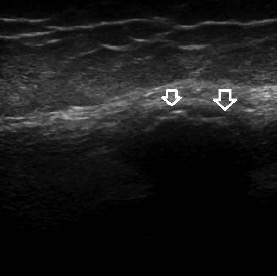 Smart Citations
Smart CitationsSee how this article has been cited at scite.ai
scite shows how a scientific paper has been cited by providing the context of the citation, a classification describing whether it supports, mentions, or contrasts the cited claim, and a label indicating in which section the citation was made.
Impact of ultrasonography detected quadriceps calcific tendinopathy on pain and function in patients with primary knee osteoarthritis
Calcific tendinopathy is most commonly seen around the shoulder joint. Only a few cases of quadriceps calcific tendinopathy (QCT) were reported. This study compares pain, function, clinical examination results, and ultrasonographic findings among primary knee osteoarthritis (KOA) patients with or without ultrasonography-detected QCT. A cross-sectional study was conducted on 214 patients with knee OA. Ultrasonography (US) of knee joints was performed according to the EULAR guidelines. Kellgren-Lawrence radiographic grading was used to score OA. Pain and functional status were assessed using the visual analog scale (VAS), the Health Assessment Questionnaire-II (HAQ-II), and the Western Ontario and McMaster Universities Osteoarthritis Index (WOMAC). QCT was detected in 50 out of 428 knees (11.6%), i.e. in 46 out of 214 patients (21.49%). Most cases of QCT were detected in the following sites: 36 in the vastus lateralis (72%), 10 in the vastus intermedius (20%), and only 4 in the vastus medialis (8%). QCT was found mainly in advanced KOA stages: 44 cases of QCT were found in patients with grade 4 KOA and 6 cases in grade 3 KOA. The presence of QCT showed a statistically significant association (p<0.05) with VAS, HAQ-II, WOMAC subscales, synovitis, and effusion detected by US. In knees with ultrasound-detected QCT, ultrasonographic features of CPPD were found in 31 knees (62%). QCT was found in cases with advanced KOA and mainly with ultrasonographic findings of CPPD disease. QCT could be considered an independent poor prognostic finding regarding pain, functional activity, and response to NSAIDs.
Downloads
How to Cite
Authors who publish with this journal agree to the following terms:
- Authors retain copyright and grant the journal right of first publication with the work simultaneously licensed under a Creative Commons Attribution License that allows others to share the work with an acknowledgement of the work's authorship and initial publication in this journal.
- Authors are able to enter into separate, additional contractual arrangements for the non-exclusive distribution of the journal's published version of the work (e.g., post it to an institutional repository or publish it in a book), with an acknowledgement of its initial publication in this journal.
- Authors are permitted and encouraged to post their work online (e.g., in institutional repositories or on their website) prior to and during the submission process, as it can lead to productive exchanges, as well as earlier and greater citation of published work.

 https://doi.org/10.4081/reumatismo.2021.1381
https://doi.org/10.4081/reumatismo.2021.1381





